Native Plants
Search for native plants by scientific name, common name or family. If you are not sure what you are looking for, try the Combination Search or our Recommended Species lists.
Ulmus americana
Ulmus americana L.
American Elm, White Elm, Soft Elm, Water Elm, Common Elm
Ulmaceae (Elm Family)
Synonym(s): Ulmus americana var. floridana, Ulmus floridana
USDA Symbol: ulam
USDA Native Status: L48 (N), CAN (N)
Three distinct habits are recognized including the vase-shaped form in which the trunk divides into several erect limbs strongly arched above and terminating in numerous slender, pendulous branchlets. A more wide-spreading and less arching form occurs, as well as a narrow form with branchlets clothing the entire trunk. The species usually grows 60-80 ft. Dark-green leaves have variable fall color. Large, handsome, graceful tree, often with enlarged buttresses at base, usually forked into many spreading branches, drooping at ends, forming a very broad, rounded, flat-topped or vaselike crown, often wider than high.
This well-known, once abundant species, familiar on lawns and city streets, has been ravaged by the Dutch Elm disease, caused by a fungus introduced accidentally about 1930 and spread by European and native elm bark beetles. The wood is used for containers, furniture, and paneling. Because of its fundamental architectural form, this is the ideal street tree. Its branches meet across the road in a vaulted arch that permits the passage of high vehicles.(Peattie)
Plant Characteristics
Duration: PerennialHabit: Tree
Leaf Retention: Deciduous
Leaf Arrangement: Alternate
Leaf Complexity: Simple
Leaf Shape: Elliptic , Oval
Leaf Venation: Pinnate
Leaf Margin: Double-serrate
Leaf Apex: Acuminate , Acute
Leaf Base: Oblique
Leaf Texture: Smooth
Fruit Type: Samara
Size Notes: Tree up to 100 feet tall, with a trunk diameter up to more than 6 feet in very old trees; crown vase-shaped, widely spreading.
Leaf: Alternate, simple, oval to elliptic, pointed at the tip, strongly asymmetrical at the base, coarsely doubly toothed, smooth or somewhat rough to the touch on the upper surface, pale and smooth or soft-hairy on the lower surface, up to 6 inches long, up to 3 inches broad, with a short stalk.
Autumn Foliage: yes
Flower: Drooping clusters of 3-4, appearing before the leaves, small, hairy.
Fruit: Samaras ovate to oval, veiny, flat, smooth on the faces but densely ciliate along the edges, with a small perforation near the top.
Bloom Information
Bloom Color: Red , GreenBloom Time: Feb , Mar , Apr
Distribution
USA: AL , AR , CT , DC , DE , FL , GA , IA , IL , IN , KS , KY , LA , MA , MD , ME , MI , MN , MO , MS , MT , NC , ND , NE , NH , NJ , NY , OH , OK , PA , RI , SC , SD , TN , TX , VA , VT , WI , WV , WYCanada: MB , NB , NS , ON , PE , QC , SK
Native Distribution: N.S., s. Man & s.e. Sask. & Crook Co. WY, s. to FL & c. TX
Native Habitat: Stream banks; lowland areas
Growing Conditions
Water Use: HighLight Requirement: Sun , Part Shade
Soil Moisture: Moist
Soil pH: Circumneutral (pH 6.8-7.2)
CaCO3 Tolerance: Medium
Soil Description: Moist, fertile soils. Sandy, Sandy Loam, Medium Loam, Clay Loam, Clay, Limestone-based
Conditions Comments: Prefers full sun and well drained soils. Good heat tolerance. Susceptible to Dutch elm disease.
Benefit
Use Ornamental: Shade tree, Fast growing, Attractive, Fall conspicuousUse Wildlife: Seeds-granivorous birds,Cover,Nesting site,Substrate-insectivorous birds,Seeds-Small mammals, Browse.
Use Other: Because it is relatively odourless, the wood was used to make crates and barrels for cheeses, fruits and vegetables.
Attracts: Birds , Butterflies
Larval Host: Mourning Cloak, Columbia silkmoth, Question Mark butterfly, Painted Lady butterfly, Comma buterfly.
Butterflies and Moths of North America (BAMONA)
|
Eastern Comma (Polygonia comma) 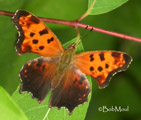 Larval Host |
Mourning Cloak (Nymphalis antiopa) 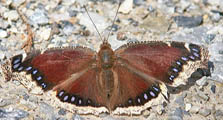 Larval Host |
Columbia silkmoth (Hyalophora columbia) 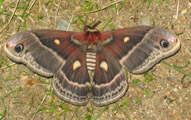 Larval Host |
Question Mark (Polygonia interrogationis) 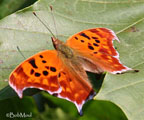 Larval Host |
|
Painted Lady (Vanessa cardui) 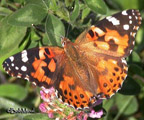 Larval Host |
Find Seed or Plants
View propagation protocol from Native Plants Network.
Mr. Smarty Plants says
Trees that are non-toxic for horses
May 02, 2008
I live in Ponder, Tx. We have some acreage and horses and wish to plant trees to afford some shade for the horses. Can you tell me what trees are toxic to horses.
view the full question and answer
Plants for wildlife and trees for shade.
September 29, 2007
We live in Kempner Texas, our land has mostly cedar trees. We would like to make a wildlife habitat on the back side of our property. Can you recommend plants that will grow in shade to partial sun,...
view the full question and answer
Native trees for cemetery plot in Karnes County, TX
April 08, 2007
I'm looking for a tree for a cemetery plot in Karnes County at Pana Maria. There will be someone to regularly water it. I understand live oak and pecan are native to the area. I assume these would...
view the full question and answer
National Wetland Indicator Status
| Region: | AGCP | AK | AW | CB | EMP | GP | HI | MW | NCNE | WMVE |
| Status: | FAC | FAC | FACW | FAC | FACW | FACW | FAC |
From the National Organizations Directory
According to the species list provided by Affiliate Organizations, this plant is on display at the following locations:Lady Bird Johnson Wildflower Center - Austin, TX
Pineywoods Native Plant Center - Nacogdoches, TX
Brackenridge Field Laboratory - Austin, TX
Nueces River Authority - Uvalde, TX
Stengl Biological Research Station - Smithville, TX
Texas Parks and Wildlife Department - Austin, TX
NPSOT - Fredericksburg Chapter - Fredericksburg, TX
Jacob's Well Natural Area - Wimberley, TX
Bibliography
Bibref 1255 - Bringing Nature Home: How You Can Sustain Wildlife with Native Plants (2009) Tallamy, Douglas W.Bibref 1186 - Field Guide to Moths of Eastern North America (2005) Covell, C.V., Jr.
Bibref 298 - Field Guide to Texas Trees (1999) Simpson, B.J.
Bibref 1185 - Field Guide to Western Butterflies (Peterson Field Guides) (1999) Opler, P.A. and A.B. Wright
Bibref 354 - Native & Naturalized Woody Plants of Austin & the Hill Country (1981) Lynch, D.
Bibref 318 - Native Texas Plants: Landscaping Region by Region (2002) Wasowski, S. & A. Wasowski
Bibref 400 - Natural History of Trees of Eastern & Central North America (1991) Peattie, D.C. & P. H. Landacre
Bibref 291 - Texas Wildscapes: Gardening for Wildlife (1999) Damude, N. & K.C. Bender
Bibref 297 - Trees of Central Texas (1984) Vines, Robert A.
Search More Titles in Bibliography
Web Reference
Webref 17 - Southern Wetland Flora: Field Office Guide to Plant Species (0) U.S. Department of Agriculture. No date. Southern wetland flora: Field office guide to plant species. U.S.D.A. Soil Conservation Service, South Nat...Additional resources
USDA: Find Ulmus americana in USDA PlantsFNA: Find Ulmus americana in the Flora of North America (if available)
Google: Search Google for Ulmus americana
Metadata
Record Modified: 2015-10-13Research By: TWC Staff